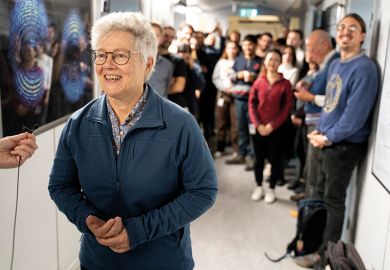It is the coldest spell of the winter and the boiler has stopped working. The plumber, having dropped off some emergency heaters, stops in the doorway and says, rather surprisingly: “Can I ask you something? Is there anything at all in the empty space inside atoms?”
Earlier, over a cup of tea and a Jammie Dodger, he has shown an interest in matters scientific, so I know what he is alluding to: a whopping 99.9999999999999 per cent of the atoms of which you and I are made are empty. There follows a discussion on the draughty doorstep of how, according to modern physics, nothing is really empty but instead a seething sea of “zero-point quantum fluctuations”.
Because I write about science for a lay audience, people often quiz me about life, the universe and everything – although rarely plumbers. And it is striking how they like to ask the big cosmic questions or eavesdrop on a scientific conversation.
This has not gone unnoticed by University of Southern California physicist Clifford Johnson. In his graphic novel, The Dialogues: Conversations about the Nature of the Universe, the reader is a fly on the wall on trains and in coffee bars and in other public places when a lay-person – just like my quantum plumber – gets into conversation with a physicist or a cosmologist about the big unanswered questions in science.
As I started reading The Dialogues, I was unconvinced that the book would work. The conversations come over as a little stilted, lacking in humour or even in the quirkiness of normal everyday speech. However, as I read on and gave the book more of a chance, I gradually became hooked. Deep subjects are given an airing – relativity, quantum theory, the nature of space and time, the origin of the universe, the existence of God, and even the process by which science is done. A very striking image shows scientists trying to piece together a jigsaw when they do not know the final picture, do not possess all the jigsaw pieces and are not even sure that the jigsaw pieces they have are the right ones.
I gained many new insights. For instance, although I knew the role of Einstein in predicting the existence of gravitational waves in 1916, I had overlooked his role in the detection of these ripples in the fabric of “space-time” almost a century later on 14 September 2015. As Johnson points out, gravitational waves were picked up with the aid of lasers, which are a consequence of the quantum effect of the “stimulated emission”, which was also predicted by Einstein.
There is nothing new under the sun. And Johnson has merely revived an old method of presenting scientific ideas. As Nobel prizewinner Frank Wilczek points out in the foreword, scientists – most notably Galileo – presented their ideas in dialogue between debating characters on which readers could eavesdrop. And, given the chance, I bet that many of us would love the chance to quiz an Einstein down the pub. Since that is rarely, if at all, possible, The Dialogues is the next best thing.
Marcus Chown is the author of The Ascent of Gravity, The Sunday Times Science Book of 2017.
The Dialogues: Conversations about the Nature of the Universe
By Clifford Johnson
MIT Press, 246pp, £24.95
ISBN 9780262037235
Published 12 January 2018
Register to continue
Why register?
- Registration is free and only takes a moment
- Once registered, you can read 3 articles a month
- Sign up for our newsletter
Subscribe
Or subscribe for unlimited access to:
- Unlimited access to news, views, insights & reviews
- Digital editions
- Digital access to THE’s university and college rankings analysis
Already registered or a current subscriber? Login







